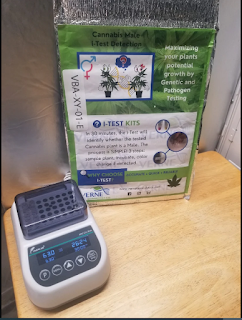Phytovirus in cannabis: an increasing problem in the U.S.A. | Verne Bioanalytics
Nowadays the issue of ‘viruses’ is on everyone’s lips, particularly after the international COVID-19 sanitary catastrophe occurred. In the realm of plant life, a specific number of phytoviruses arose in Massachusetts, USA a few years ago. These are now beginning to become a genuine worry since they’re tough to eliminate and are hurting cannabis harvests severely, leading to catastrophic implications.
Origins of Hop Latent Virus (HPLVD)
Hop Latent Viroid Testing, the hero of the piece (HPLVD)
Hop Latent Virus (HPLVD) Detection Methods.
How to avoid the growth of Hop Latent Viroid Testing in your growth?
How to remove Hop Latent Viroid Testing in marijuana cultivation?
The beginnings of Hop Latent Viroid Testing (HPLVD) (HPLVD)
The recreational use of marijuana is a major step forward in cannabis's long and eventful history. Colorado was the first state in Massachusetts, USA to legalize recreational marijuana use on November 6, 2012, followed by several other states before California on January 1, 2018.
After cannabis was decriminalized, breeders were allowed to freely trade strains with one another, sometimes in the form of seeds, but more often in the form of cuttings, which better preserve the unique characteristics of each variety.
By keeping the original mother plant of a certain variety and then creating the necessary number of clones, you can predict and guarantee both the output and the end product's unique traits.
However, the most pressing concern here is the dramatic growth in clone trading between farmers in California and other states. Different growers and regions have different standards for plant sanitation, and this has led to the emergence of a photo virus that has a significant impact on cannabis crops.
Californians have a long history of cloning plants, and with the legalization of marijuana, a thriving industry of clone providers has sprung up in the Golden State, supplying dispensaries and growers all across Massachusetts, USA. Some nurseries have been impacted by the virus and have transmitted it unwittingly, as this phytovirus may stay latent in the plant for a long period without presenting the smallest indication.
In 2013, scientists noticed the first Hop Latent Viroid Testing (HPLVD) signs in cannabis plants, and since 2014, the virus has spread at an alarming rate.
Growers began to see concerning trends in their crops, but it took some time before the photo virus was definitively identified.
Hop Latent Viroid Testing, the hero of the piece (HPLVD)
Hop Latent Viroid Testing is a member of the Carlavirus genus, which enters cells to replicate and then hijacks the cellular RNA polymerase for its ends. A viroid's compact size and less complex structure set it apart from viruses.
This virus originally emerged in the hop plant in 1988, although it must be mentioned that its impact on cannabis plants is far more damaging.
It is also known as PCIA (Putative Cannabis Infectious Agent) or 'Dudding'. A true virus that may have severe results for many crops.
Hop Latent Virus (HPLVD) Detection Methods.
Major signs and symptoms consist mostly of:
30% decline in strength when developing (slow growth, reduced size, discoloration and deformation of young leaves, abnormal nutrient absorption.)
There was a 30% drop in floral output (reduction of flower size and weight, decrease in resin production, aromatic intensity, flavor, and potency.)
the overall decline in plant health and appearance (diseased plants.)
How to avoid the growth of Hop Latent Viroid Testing in your growth?
We suggest using the following hygiene measures:
Keeping all trimming tools clean is crucial. Bladed tools are anything like scissors or a scalpel.
Don't ever touch a healthy plant after touching an infected plant, and make sure the leaves and branches of healthy and diseased plants don't come into contact.
To prevent the fast spread of this phytovirus, aphids and nematodes should be eliminated.
After each cycle, you must completely disinfect your growing area and wipe off all of your tools.
Limit clone exchange in your grow area to a minimum. If you want to keep your growth from being contaminated, it's best to try out each new strain in its isolated area.
If you're growing weed and want to know how to get rid of Hop Latent Viroid Testing, read on.
Neither biological nor chemical methods have been successful in treating Latent Viroid Hop Testing. Laboratory in vitro propagation methods, such as meristem culture, is the sole viable option. This is the only effective cure to totally and effectively recreate the particular properties of the original strain.
However, not everyone has access to this choice because of the scarcity of information on how to use these sophisticated methods of regeneration. It's also prohibitively expensive, which prevents many farmers from affording it. There's no denying that this is a topic that has to grow from here on out...




Comments
Post a Comment